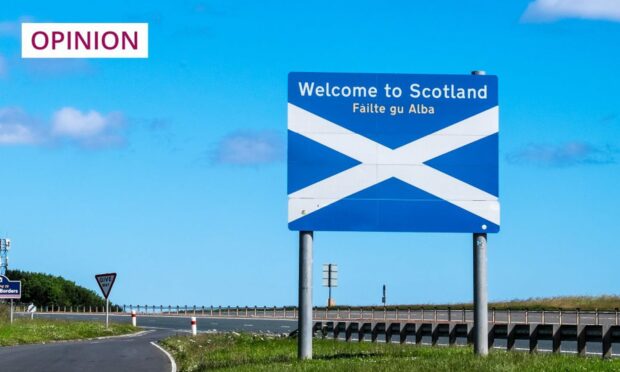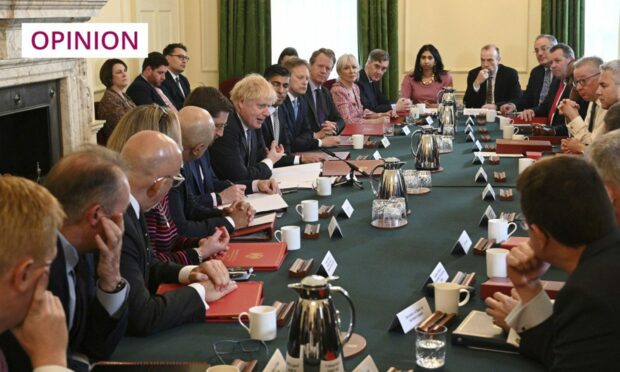Folk etymology is a wonderful thing.
It’s when ordinary folk give a perfectly reasonable – though false – explanation for the meaning of a word. It’s the same as an urban legend, which gains more and more traction as it’s repeated.
Some years ago, my wife was travelling on the bus between Glasgow and Skye and, because she was sitting at the front, got talking to the driver. He was from Greenock.
The place name comes from the original Gaelic “Grianaig”, which basically means “a sunny or gravelly knoll”. Though the bus driver told her differently, saying it was simply “green oak” after a tree in the town, which he’d seen for himself. Which goes to prove that we see what we want to see.

One of my favourite stories concerns the derivation of two London burghs – Putney and Fulham. The derivation was given in 1895 by an old resident of Chelsea, who knew it as a matter of local tradition.
This is how they got their names, she said – two giantesses were each building a church on opposite sides of the Thames. Between them, however, they only had one hammer, so when the Surrey giantess wished to drive a nail in, she called to her friend: “Put it nigh”, and when the Middlesex giantess next dealt with a nail, she shouted: “Send it full home”.
Thus, the churches and then the districts came to be known as Fulham and Putney, said the old lady.
Don’t get too precious about words and their meanings
It’s to do with balancing belief, and reminds me of another of my favourite stories of the same vintage, which I collected during my researching in the National Library of Scotland a couple of years ago.
Daybreak used to be called by the marvellous names of ‘sky-casting’ or ‘sky-making’ in parts of north-east Scotland
In 1883, a clergyman in Wrexham wrote down the following: “An old woman in Bristol told me that there was a charm against toothache in the Bible. I expressed my surprise, but she assured me it was so, so I told her I would look. Next week, I told her I could not find it anywhere, so she said: ‘Yes, that’s just it; it’s there, certainly, but the more you look, the more you can’t find it. That’s how it always is.'”
Indeed. Nearer home, I was down at Spean Bridge railway station a few weeks ago and there’s a sign there telling of the train’s destination. It reads An Gearastan, in Gaelic, literally translating as The Fort. Though, on the other platform, a woman was explaining the words to a gentleman, telling him: “That means Fort William. ‘An’ means ‘Fort’ and ‘Gearastan’ means William.”
I was delighted to hear it, because we can get too precious about these things. For, what are words anyway, but fluid creative sparks to enliven our lives?
Daybreak, for example, which they used to call by the marvellous names of “sky-casting” or “sky-making” in parts of north-east Scotland, according to an old paper I also read in the National Library of Scotland, connected to the sea-lore of the area.
These words were collected in the 1890s and I’m not sure how many, if any, are still extant, though I’d be delighted to hear if they are.
A bleerie, a bleeze or a bonniething
Amongst the many word jewels collected were these: a piece of rainbow on the horizon was called a “bleerie” or a “bleeze” or a “bonniething” or a “fiery eee” or a “fiery tooth” or a “rawnie” in Macduff, called a “rose” in Nairn, a “giltin” in St Combs, a “fire” in Buckie and – my favourite – a “silk-napkin” in Crovie.
And there were a couple of lovely things from Nairn, where they called the Milky Way “The White Ship”, and John Stro was the name of the man in the moon. He was spoken of as “the man wi’ the birn o’ sticks on ’s back”.
But, one of my favourite things is when a guid Scots tongue is used in business dealing. To mak’ some siller, as they’d say.
One of the finest examples I know was highlighted by my friend and great Doric scholar, Derrick C McClure, some years ago – composed by a Buchan loon, Robert Forbes, who ran a hosier’s business in London in the 18th century. He had not forgotten his native tongue, however.
Here’s how he invoiced his customers far and wide:
“To ilka body be it kend’,
Frae John-A-groats to the land’s end,
That frae this day I do intend,
Some shanks to sell,
This is my bill, to you I send…”
That’s definitely going on my next invoice.
Angus Peter Campbell is an award-winning writer and actor from Uist








